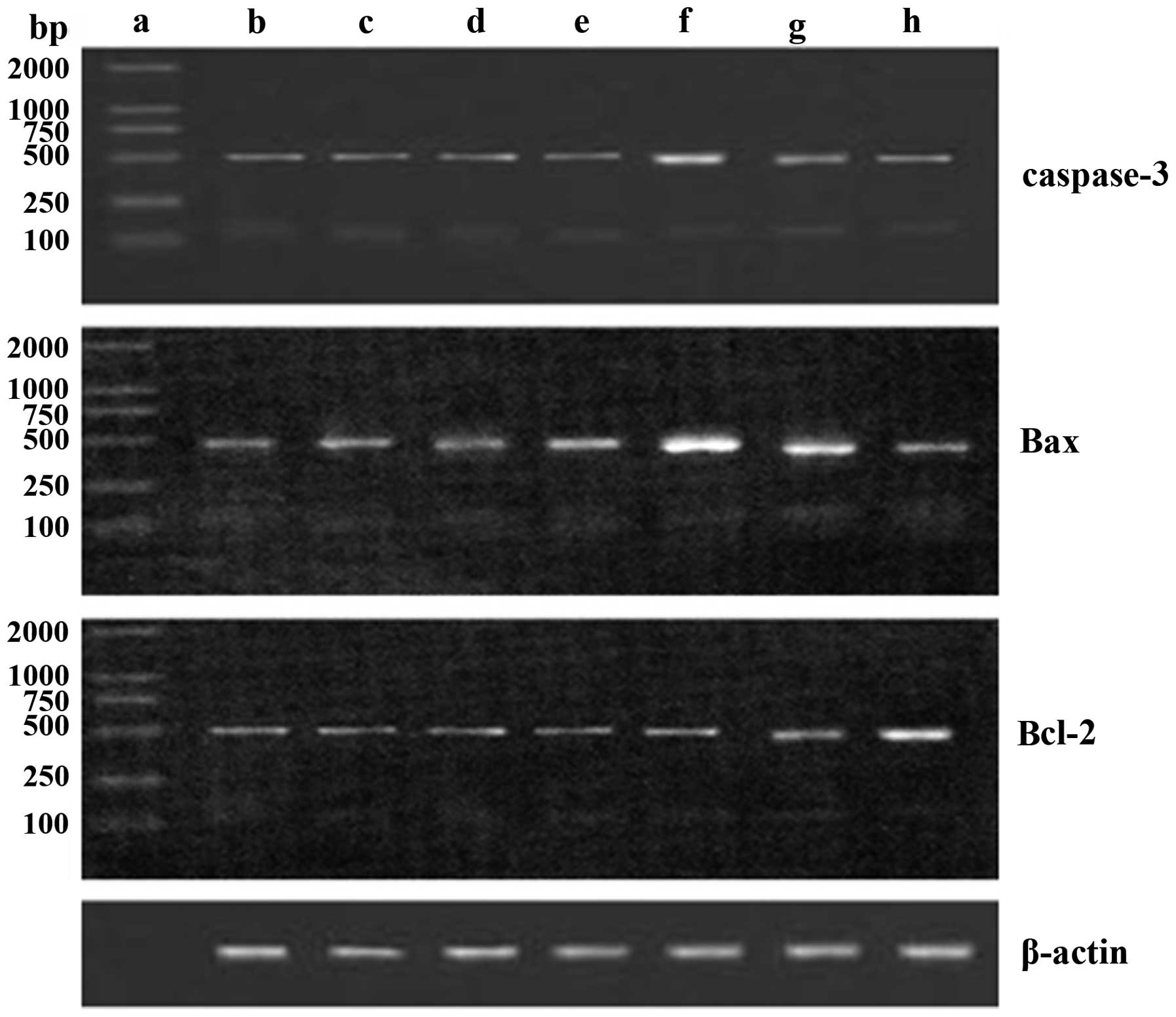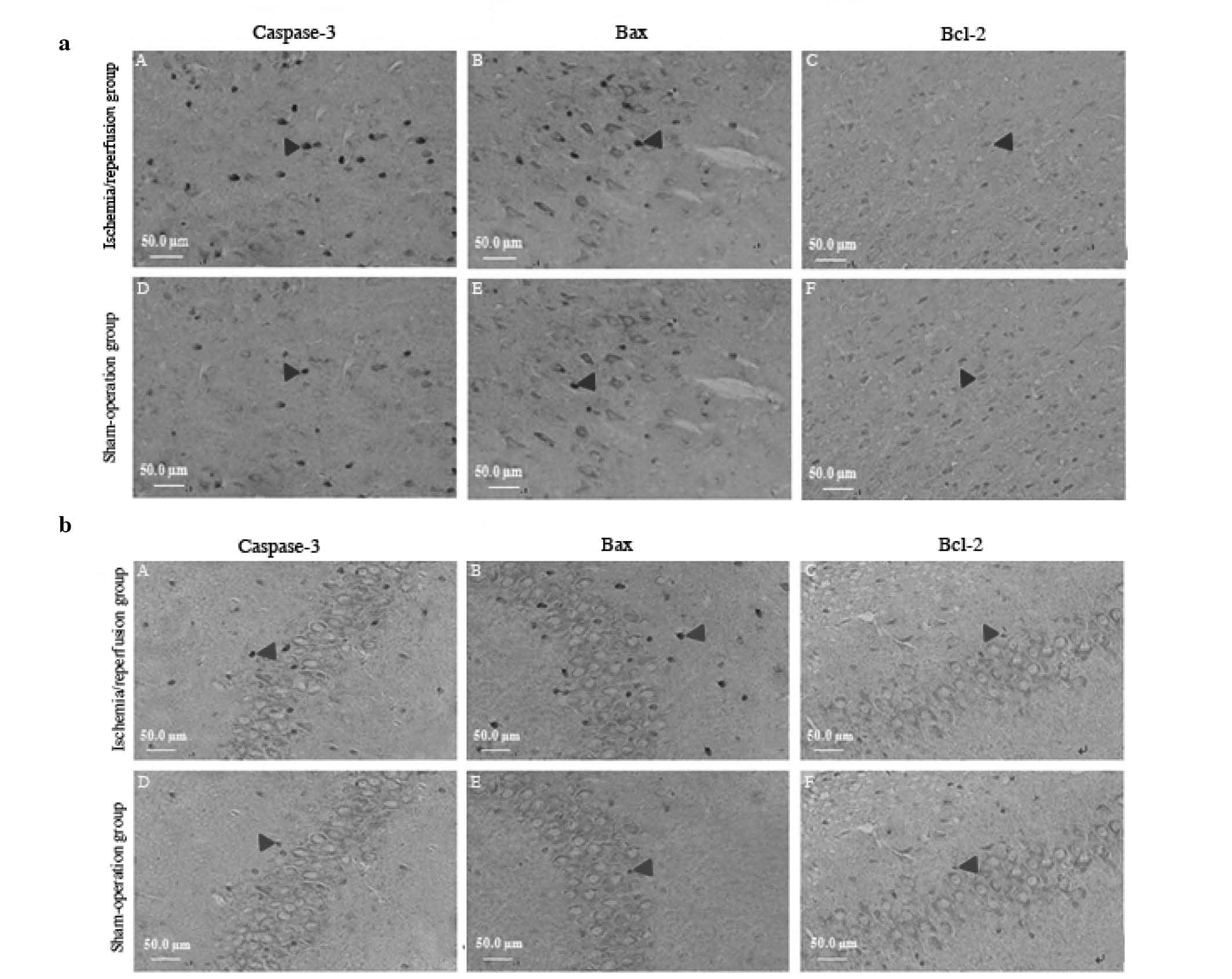Effects of apoptosis‑related proteins caspase‑3, Bax and Bcl‑2 on cerebral ischemia rats
- Authors:
- Guangyi Liu
- Tao Wang
- Tinging Wang
- Jinming Song
- Zhen Zhou
-
View Affiliations
Affiliations: Institute of Cerebrovascular Diseases, Affiliated Hospital of Qingdao University Medical College, Qingdao, Shandong 266003, P.R. China, Department of Neurology, The Central Hospital of Taian, Taian, Shandong 271000, P.R. China, Institute of Cerebrovascular Diseases, Affiliated Hospital of Qingdao University Medical College, Qingdao, Shandong 266003, P.R. China
- Published online on: July 29, 2013 https://doi.org/10.3892/br.2013.153
-
Pages:
861-867
Metrics:
Total
Views: 0 (Spandidos Publications: | PMC Statistics:
)
Metrics:
Total PDF Downloads: 0 (Spandidos Publications: | PMC Statistics:
)
This article is mentioned in:
Abstract
Neuron apoptosis is known to mediate a change of ethology following cerebral ischemia̸reperfusion injury in rats. Additionally, Bcl‑2, Bax and caspase‑3 proteins may exert a significant effect on neuron injury. The aim of this study was to investigate the role, mechanism of action and clinical significance of these proteins in neuron apoptosis and functional impairment following cerebral ischemia̸reperfusion injury in rats. Sixty male healthy adult Wistar rats were randomly assigned into control (n=6), sham operation (n=6) and experimental (n=48) groups. The model of rat cerebral ischemia̸reperfusion injury was set up according to the method of Zea‑Longa. Eight subsets of 6 rats̸subset were designed according to time points (at 3, 6, 12, 24 and 48 h and at 3, 7 and 14 days). Nerve functional injury was evaluated and graded using nerve function score, balance, coordination function detection and measurement of forelimb placing. The neurons expressing caspase‑3, Bax and Bcl‑2 in the cortical area, CA3, CA1, stratum lucidum (Slu) and molecular layer of the dentate gyrus (MoDG) of the hippocampus were detected using immunohistochemistry or the TUNEL method. The expression of caspase‑3, Bax and Bcl‑2 genes was detected by the reverse transcriptase polymerase chain reaction (RT‑PCR). The results indicated that, compared to the sham operation group, the score of nerve function and balance beam walking were distinctly higher (P<0.01) and the percentage of rat foreleg touching the angle or margin of the table was significantly lower in the experimental rat group (P<0.01) at 3 h following reperfusion. The expression of TUNEL‑positive neurons was high in the cortical area and the CA3 region of the hippocampus (P<0.01), caspase‑3 was at peak value in the cortical area and the CA1 region of the hippocampus (P<0.01), Bax was increased in the cortical area and the Slu of the hippocampus (P<0.01) and Bcl‑2 was low in the cortical area and the MoDG of the hippocampus (P<0.01) in the experimental group at 48 h following reperfusion. In conclusion, cerebral ischemia/reperfusion injury may cause neurological impairment and lead to a change of ethology, and neuron apoptosis may be associated with the activation of caspase‑3 and Bax and the downregulation of Bcl‑2.
View References
|
1
|
Candelario-Jalil E: Injury and repair
mechanisms in ischemic stroke: considerations for the development
of novel neurotherapeutics. Curr Opin Investig Drugs. 10:644–654.
2009.PubMed/NCBI
|
|
2
|
Li Q, Zhang R, Guo YL and Mei YW: Effect
of neuregulin on apoptosis and expressions of STAT3 and GFAP in
rats following cerebral ischemic reperfusion. J Mol Neurosci.
37:67–73. 2009. View Article : Google Scholar : PubMed/NCBI
|
|
3
|
Li Q, Zhang R, Ge YL, Mei YW and Guo YL:
Effects of neuregulin on expression of MMP-9 and NSE in brain of
ischemia/reperfusion rat. J Mol Neurosci. 38:207–215. 2009.
View Article : Google Scholar : PubMed/NCBI
|
|
4
|
Longa EZ, Weistein PR, Calson S, et al:
Reversible middle cerebral artery occlusion without craniectomy in
rats. Stroke. 20:84–89. 1989. View Article : Google Scholar : PubMed/NCBI
|
|
5
|
Bederson JB, Pitts LH, Tsuji M, et al: Rat
middle cerebral artery occlusion: evaluation of the model and
development of a neurologic examination. Stroke. 17:472–476. 1986.
View Article : Google Scholar : PubMed/NCBI
|
|
6
|
Altumbabic M, Peeling J, Del Bigio MR, et
al: Intracerebral hemorrhage in the rat: effects of hematoma
aspiration. Stroke. 29:1917–1922. 1998. View Article : Google Scholar : PubMed/NCBI
|
|
7
|
Freeney DM, Boyeson MG, Linn RT, et al:
Responses to cortical injury: I. Methodology and local effects of
contusions in the rat. Brain Res. 211:67–77. 1981. View Article : Google Scholar : PubMed/NCBI
|
|
8
|
Bland ST, Schallert T, Strong R, et al:
Early exclusive use of the affected forelimb after moderate
transient focal ischemia in rat: function and anatomic outcome.
Stroke. 31:1144–1152. 2000. View Article : Google Scholar : PubMed/NCBI
|
|
9
|
Basso DM, Beattie MS and Bresnahan JC: A
sensitive and reliable locomotor rating scale for open filed
testing in rats. J Neurotrauma. 12:1–21. 1995. View Article : Google Scholar : PubMed/NCBI
|
|
10
|
Schmidt-Kastner R and Freund TF: Selective
vulnerability of the hippocampus in brain ischemia. Neuroscience.
40:599–636. 1991. View Article : Google Scholar : PubMed/NCBI
|
|
11
|
Xie M, Yi C, Luo X, et al: Glial gap
junctional communication involvement in hippocampal damage after
middle cerebral artery occlusion. Ann Neurol. 70:121–132. 2011.
View Article : Google Scholar : PubMed/NCBI
|
|
12
|
Ou-Yang FL, Zhou XZ, Fang SZ, Cai YQ and
Li H: Long-term behavioral and ultrastructural alterations
following hypoxic-ischemic brain damage in neonatal rats. Zhongguo
Dang Dai Er Ke Za Zhi. 14:380–384. 2012.(In Chinese).
|
|
13
|
Choi JY, Kim BM, Kim YJ, et al:
Hypoxia/reoxygenation-induced cytotoxicity in cultured human
lymphocytes. Biochem Biophys Res Commun. 352:366–371. 2007.
View Article : Google Scholar : PubMed/NCBI
|
|
14
|
Haddad JJ: The role of Bax/Bcl-2 and
pro-caspase peptides in hypoxia/reperfusion-dependent regulation of
MAPK (ERK): discordant proteomic effect of MAPK (p38). Protein Pept
Lett. 14:361–371. 2007. View Article : Google Scholar : PubMed/NCBI
|
|
15
|
Qin AP, Zhang HL and Qin ZH: Mechanisms of
lysosomal proteases participating in cerebral ischemia-induced
neuronal death. Neurosci Bull. 24:117–123. 2008. View Article : Google Scholar : PubMed/NCBI
|
|
16
|
Xing B, Chen H, Zhang M, Zhao D, Jiang R,
Liu X and Zhang S: Ischemic postconditioning inhibits apoptosis
after focal cerebral ischemia/reperfusion injury in the rat.
Stroke. 39:2362–2369. 2008. View Article : Google Scholar : PubMed/NCBI
|













